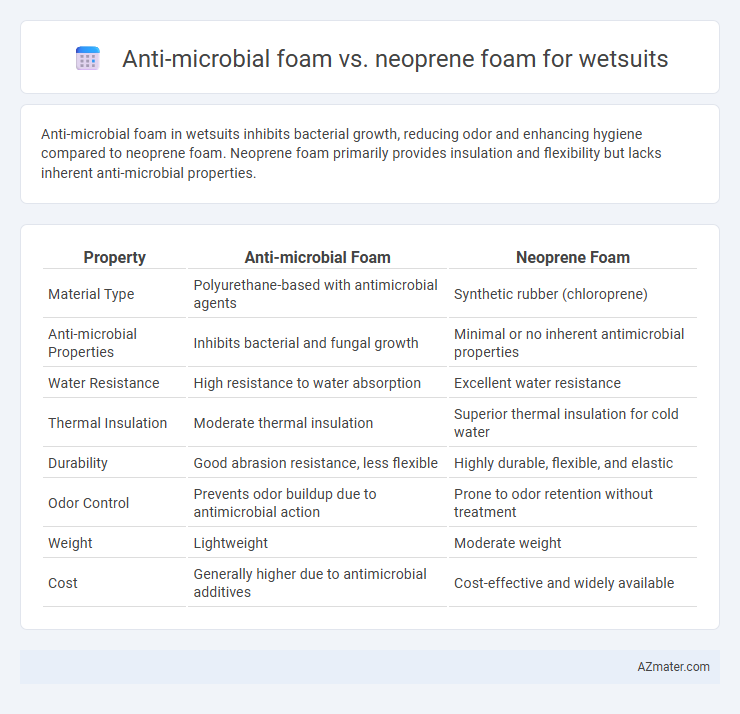Anti-microbial foam in wetsuits inhibits bacterial growth, reducing odor and enhancing hygiene compared to neoprene foam. Neoprene foam primarily provides insulation and flexibility but lacks inherent anti-microbial properties.
Table of Comparison
| Property | Anti-microbial Foam | Neoprene Foam |
|---|---|---|
| Material Type | Polyurethane-based with antimicrobial agents | Synthetic rubber (chloroprene) |
| Anti-microbial Properties | Inhibits bacterial and fungal growth | Minimal or no inherent antimicrobial properties |
| Water Resistance | High resistance to water absorption | Excellent water resistance |
| Thermal Insulation | Moderate thermal insulation | Superior thermal insulation for cold water |
| Durability | Good abrasion resistance, less flexible | Highly durable, flexible, and elastic |
| Odor Control | Prevents odor buildup due to antimicrobial action | Prone to odor retention without treatment |
| Weight | Lightweight | Moderate weight |
| Cost | Generally higher due to antimicrobial additives | Cost-effective and widely available |
Introduction to Wetsuit Materials
Wetsuit materials primarily include anti-microbial foam and neoprene foam, both essential for thermal insulation and durability in water sports. Anti-microbial foam incorporates additives that inhibit bacterial growth, reducing odor and extending the wetsuit's lifespan. Neoprene foam, known for its excellent flexibility, buoyancy, and water resistance, remains the industry standard for wetsuit construction.
What is Anti-Microbial Foam?
Anti-microbial foam in wetsuits is designed to inhibit the growth of bacteria, fungi, and mold, reducing odor and prolonging the material's lifespan. This foam incorporates additives or treatments that create an inhospitable environment for microbes, enhancing hygiene and comfort during extended water activities. Compared to neoprene foam, which primarily provides insulation and flexibility, anti-microbial foam offers added protection against microbial degradation and unpleasant smells.
Overview of Neoprene Foam
Neoprene foam is a synthetic rubber widely used in wetsuits due to its excellent insulation properties, flexibility, and durability. It provides a waterproof barrier that traps a thin layer of water warmed by the body, enhancing thermal protection in cold water conditions. Unlike anti-microbial foam, neoprene focuses primarily on temperature regulation and compression resistance, although some neoprene variants may include antimicrobial treatments to reduce odor and bacterial growth.
Key Benefits of Anti-Microbial Foam in Wetsuits
Anti-microbial foam in wetsuits offers superior resistance to odor-causing bacteria, enhancing long-term freshness and hygiene compared to traditional neoprene foam. This innovative material reduces skin irritation and the risk of infections by preventing microbial growth on the suit's surface. Lightweight and flexible, anti-microbial foam maintains excellent thermal insulation and durability while promoting a healthier wetsuit environment.
Advantages and Limitations of Neoprene Foam
Neoprene foam offers excellent insulation, flexibility, and durability, making it the preferred material for wetsuits in various water temperatures and activities. Its closed-cell structure provides superior water resistance and buoyancy; however, neoprene can be prone to degradation from prolonged UV exposure and may lose elasticity over time. Unlike anti-microbial foam, neoprene lacks inherent resistance to bacterial growth, which can lead to odors and reduced hygiene without additional treatments.
Durability Comparison: Anti-Microbial vs Neoprene
Anti-microbial foam for wetsuits offers enhanced resistance to bacterial growth, reducing odor and degradation over time, which contributes to longer-lasting freshness and material integrity. Neoprene foam is known for its excellent elasticity, insulation, and abrasion resistance, providing robust durability under various water conditions and physical stresses. Comparing durability, neoprene typically outperforms anti-microbial foam in terms of mechanical strength and lifespan, while anti-microbial foam excels in maintaining hygiene and preventing microbial damage.
Comfort and Flexibility: Material Performance
Anti-microbial foam in wetsuits offers enhanced comfort by reducing odor-causing bacteria and maintaining hygiene during prolonged use. Neoprene foam provides superior flexibility and thermal insulation, allowing for greater freedom of movement in water activities. Combining anti-microbial properties with neoprene's elasticity improves overall material performance, ensuring both comfort and flexibility for wetsuit wearers.
Hygiene and Odor Resistance: Which Foam Wins?
Anti-microbial foam in wetsuits significantly reduces bacterial growth, which prevents odor buildup and enhances long-term hygiene compared to traditional neoprene foam. Neoprene foam lacks inherent antimicrobial properties, often resulting in faster odor retention after repeated use without proper drying and care. For maintaining freshness and reducing unpleasant smells, anti-microbial foam clearly outperforms neoprene foam in wetsuit applications.
Environmental Impact of Both Materials
Anti-microbial foam in wetsuits often incorporates biocidal agents that can leach into marine environments, potentially harming aquatic ecosystems. Neoprene foam, primarily derived from non-renewable petrochemicals, poses significant environmental concerns due to its energy-intensive production and challenges in biodegradability. Comparing the two, anti-microbial foam may introduce chemical pollutants, whereas neoprene contributes to long-term plastic pollution, making sustainable alternatives critical for reducing wetsuit environmental footprint.
Which Wetsuit Foam is Best for You?
Anti-microbial foam in wetsuits offers superior resistance to bacteria and odor, ensuring longer freshness during extended water activities, making it ideal for frequent surfers or divers. Neoprene foam provides excellent insulation and flexibility, delivering optimal warmth and comfort in colder waters or high-performance scenarios. Choosing the best wetsuit foam depends on your specific needs: prioritize anti-microbial foam for hygiene and odor control, or neoprene foam for thermal protection and elasticity.

Infographic: Anti-microbial foam vs Neoprene foam for Wetsuit
 azmater.com
azmater.com